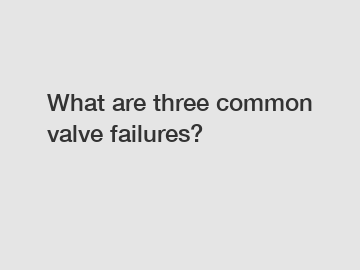Google Hot Topics:
- Common valve failures in industrial settings.
- How to prevent valve failures.

- Signs of valve failure to watch for.
- Importance of regular valve maintenance.
Valves are crucial components in various industrial processes as they help control the flow of liquids, gases, and other substances. However, like any mechanical device, valves are prone to failure over time, which can lead to costly downtime and potential safety hazards. In this article, we will explore three common valve failures and discuss how you can prevent them from occurring.
1. Leakage:
One of the most common valve failures is leakage, which occurs when a valve fails to fully close, allowing fluid to escape. This can lead to a loss of product, energy inefficiency, and environmental contamination. Leakage can be caused by several factors, including worn seals, corrosion, or improper installation.
To prevent leakage, it is essential to regularly inspect valves for any signs of wear and tear, such as leaking seals or visible corrosion. Proper installation and maintenance of valves can also help prevent leakage by ensuring that valves are properly aligned and sealed.
2. Blockage:
Another common valve failure is blockage, which occurs when debris or sediment clogs the valve's passageways, preventing proper flow. Blockage can lead to decreased efficiency, increased pressure drop, and eventual valve failure. Factors such as improper fluid filtration, poor maintenance practices, or inadequate valve sizing can contribute to blockage.
To prevent blockage, it is important to regularly clean and inspect valves to remove any debris or sediment buildup. Proper fluid filtration and regular maintenance can help prevent blockage by ensuring that valves remain clear and free-flowing.
3. Sticking:
Sticking is another common valve failure that occurs when a valve's moving parts become jammed or stuck in position, preventing proper operation. Sticking can be caused by factors such as lack of lubrication, temperature fluctuations, or improper alignment. Sticking valves can lead to erratic operation, increased wear on valve components, and potential system damage.
To prevent sticking, it is important to regularly lubricate valve components to ensure smooth operation. Proper alignment and regular maintenance can also help prevent sticking by ensuring that valves are correctly positioned and free-moving.
In conclusion, understanding the common causes of valve failures and taking proactive measures to prevent them can help minimize downtime, reduce maintenance costs, and ensure the safe and efficient operation of industrial processes. By regularly inspecting valves, addressing any signs of wear or damage, and implementing proper maintenance practices, you can help extend the lifespan of your valves and prevent costly failures. Remember, prevention is key when it comes to ensuring the reliability and performance of your valves in industrial settings.
The company is the world’s best hydraulic one way valve, wholesale tubular check valve Price, Electromagnetic Relief Valve for Sale supplier. We are your one-stop shop for all needs. Our staff are highly-specialized and will help you find the product you need.



Comments
Please Join Us to post.
0